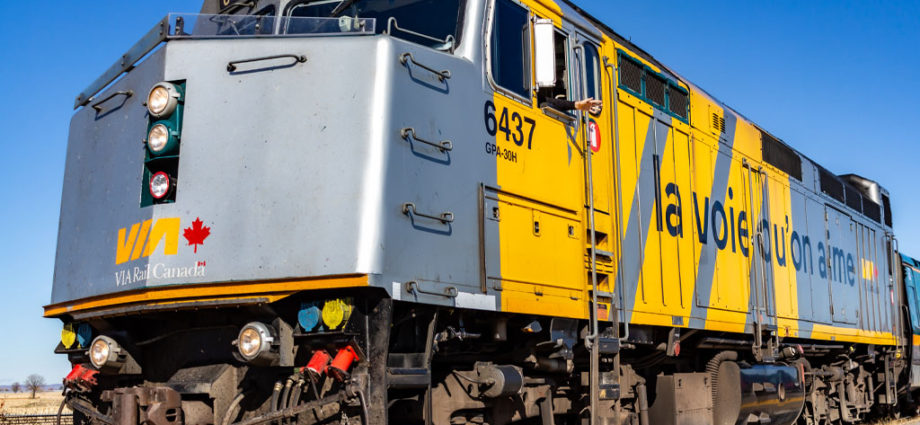
Full speed ahead for high-frequency rail in the busy Canadian corridor?
A locomotive engineer waves from a VIA Rail train as it departs Fallowfield Station in Ottawa’s Barrhaven neighbourhood in 2019. Shutterstock
The Liberals’ first step toward new train service could be a springboard for a train-centric sustainable post-pandemic transportation network.
by Matthew Boulden, Daniel Béland. Originally published on Policy Options
September 30, 2021
Canada’s languishing passenger rail service appears to have seen its first step in the right direction in generations. On July 6, the transport minister at the time, Omar Alghabra, announced the government is committing to the procurement process for a long-awaited high-frequency rail (HFR) project. It has taken five years of study to put in place VIA Rail’s proposal for building dedicated passenger tracks to offer faster, more convenient, more frequent and more reliable service in the Quebec City-to-Toronto corridor.
But getting to this point has been no simple task.
Several factors have played a key role, including a strategic effort by VIA Rail to establish broad support for the proposal in advance of the decision-making timeline; a strong fit between the proposal and key elements of the Liberal government’s re-election platform; convenient timing with the political calendar of the government; and, finally, the unforeseen benefit of meshing with the post-pandemic “build back better” approach of the government.
Originally proposed by VIA Rail in the final years of the Harper government, the then-flailing train company pitched its HFR plan with dedicated tracks as a way of moving off the perpetually delayed shared freight tracks owned by CN and CP. With the election of Justin Trudeau’s Liberal government in 2015, VIA Rail began to emphasize the connections between HFR’s key benefits and this new administration’s top priorities.
The advantages included ecological sustainability, its capacity to generate economic growth and its ability to serve the mobility needs of numerous constituencies at a time of increasing ridership. With the creation of the Canadian Infrastructure Bank in 2017, the capacity to finance HFR improved because the project met many of the criteria for funding and also had the potential to attract private investors.
Following the 2014 unveiling of its plans for dedicated tracks, VIA held numerous consultations over the next few years with mayors, city councils, federal and provincial elected officials, chambers of commerce and other interest groups. In doing so, it strategically assembled broad support for the project across Ontario and Quebec. Countless letters to federal cabinet members from these stakeholders emphasized palpable enthusiasm for the project. Likely sensing its political popularity, the Liberal government made its July announcement of a major assessment of the HFR project, – all while touting how the project would simultaneously serve the interests of these constituencies and contribute to a more sustainable transportation network.
Cabinet approval was no doubt influenced in part by the ever-influential political calendar: the announcement came just months before voters headed to the polls on Sept. 20.
Two smaller cities, nonetheless, did not reward the Liberals with a win: Trois-Rivières and Peterborough, even though they would benefit the most from the service. There is an explanation for this. The Liberal government inevitably took much of the credit for moving HFR along, but the project received political buy-in from each of the major parties well before this election campaign, and that support has not wavered. This could be why voters in neither city rewarded the Liberal government for pushing forward with HFR. Without any significant opposition and a chorus of local MPs from different parties singing its praises, it appears to be politically entrenched.
Another critical factor for the approval: economic recovery from the global pandemic. Like governments around the world, the Liberals are seeking to “build back better” and take advantage of low interest rates. Now seems to be the right moment for investments in transportation infrastructure projects. In a stroke of good timing, the plans for the project were nearly fully assessed and finalized just as Canada was responding to the emergence of COVID-19 and therefore seeking to invest in the economic rebound and rebuilding areas of lacklustre infrastructure.
Even with all these pieces falling into place, it still took the government considerable time to approve and begin the procurement process for the relatively simple HFR project. This does not bode well for more costly or challenging passenger rail initiatives. The Liberal government deserves recognition for committing to HFR and taking the steps to reverse decades of stagnant passenger rail policy, but there is still lingering disappointment over how long this process lasted and what major obstacles had to be overcome.
Yet, there is still plenty of reason to be hopeful about this major improvement to Canada’s passenger rail systems. In the most ideal scenario, the successful implementation and operation of HFR leads policy-makers to re-evaluate the decades-long hesitancy to invest in passenger rail. With more Canadians seeing the perks of fast intercity rail transit, perhaps this will open the door to even larger projects with greater ecological benefits and major socioeconomic advantages.
Subscribe to our newsletter.
Rather than being just a cheap fix or a flashy campaigning tool, the approval of HFR could serve as a springboard for the revival of serious discussions about high-speed rail, high-performance rail and a broad refocusing on trains as the centrepiece of a sustainable post-pandemic transportation network. Indeed, HFR’s broad political appeal raises the question of whether a major shift in Canadians’ transportation priorities has already begun. Could this mark a new chapter for the future of Canadian passenger rail policy?
This article first appeared on Policy Options and is republished here under a Creative Commons license.


